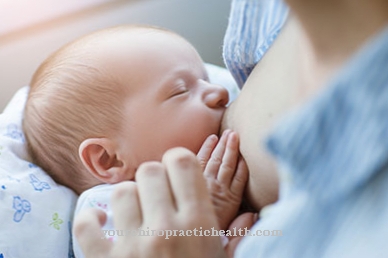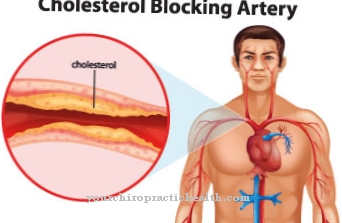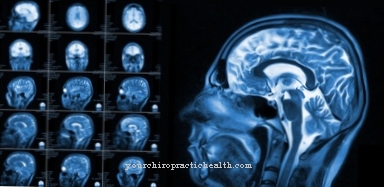Anyone who travels a lot can use the cutaneous leishmaniasis, a disease of the skin and mucous membranes for which there is no vaccine and which can be serious with a number of complications. Popularly it is also called Orient bump known. Holidaymakers should therefore take preventive measures as much as possible and consult a doctor if the symptoms of cutaneous leishmaniasis are typical.
What is Cutaneous Leishmaniasis?

© Mongkol Chuewong - stock.adobe.com
The cutaneous leishmaniasis is an infectious skin disease. Its name comes from the pathogens that cause the disease.
These are different parasites, all of which belong to the genus Leishmania. Depending on which area of the world you are infected with the disease, the disease is due to a different type of parasite. For this reason, a distinction is made between different types of the disease, which are classified either as cutaneous leishmaniasis of the "Old World" or cutaneous leishmaniasis of the "New World".
The latter usually represents a more serious illness and can also occur as a special form, as a so-called mucocutaneous leishmaniasis, in which the mucous membranes are mainly affected instead of the epidermis. Cutaneous leishmaniasis is particularly common in southern Europe, Asia, parts of the Orient and Central and South America.
causes
The causes of illness with the cutaneous leishmaniasis are, as already mentioned, parasitic. The so-called sand or butterfly mosquito usually transmits the parasites by biting a person.
The parasites, which in biology belong to the flagellated protozoa, (also called flagellates) enter the human skin through the puncture site. There they multiply and irritate the skin in the form of lumps or ulcers. The pathogens only survive by nestling in a host. The hosts can be animals as well as humans.
For this reason, in addition to the typical transmission from a mosquito to a person, it is also possible for a person to become infected through contact with a larger animal, such as a dog or a rodent. In rare cases, direct transmission from person to person is also possible, for example through skin contact or the donation of blood and organs.
Symptoms, ailments & signs
Cutaneous leishmaniasis can cause various symptoms, depending on its type and severity. Cutaneous leishmaniasis of the “Old World” manifests itself mainly through skin changes. A few weeks after the sting, the puncture site becomes infected and swollen. Then a flat, usually painless and reddish discolored lump forms, which reaches a diameter of two to four centimeters.
Occasionally, a yellowish crust appears that is easy to scrape off. The skin change persists for several months before it heals spontaneously. Usually a scar remains, which can be associated with sensitivity disorders. Cutaneous leishmaniasis occurs mainly on bare skin areas such as the neck, arms and ankles. In individual cases, several ulcers and lumps form at the puncture site, which can persist for years and then spread to other areas of the skin.
The cutaneous leishmaniasis of the “New World” is usually more aggressive - deep skin damage and even large ulcers develop. The mucocutaneous form manifests itself in an ulcer, and in the further course in a parasitic infestation of the mucous membranes. The mucous membranes of the nose and mouth are particularly affected, which can result in impaired breathing, nosebleeds and pain. In severe cases, the parasites spread through the blood and lymph vessels and cause further complaints.
Diagnosis & course
The cutaneous leishmaniasis can be easily recognized by a medical professional based on the symptoms of the disease. These are usually reddened and swollen areas of the skin that form a shallow lump or an ulcer up to five centimeters in size.
If a patient has traveled to a risk area within the last months (sometimes even years), a first guess can be made as to which potential parasite it could be. In order to be able to detect the pathogen and thus to confirm the assumption, the doctor then carries out a tissue examination of the ulcer and prescribes a specific therapy.
If cutaneous leishmaniasis from the "Old World" is not treated, it will usually heal spontaneously after a while. Since the specific skin irritations are usually comparatively weak, they usually don't even leave scars. Nevertheless, if cutaneous leishmaniasis is suspected, a doctor should always be consulted who will determine the type of leishmaniasis.
If cutaneous leishmaniasis from the "New World" is not treated, this can have fatal consequences in some cases. For example, the mucous membranes may be destroyed or the surrounding tissue may break down. Significant optical distortions are often the result. It is not uncommon for mucocutaneous leishmaniasis to lead to secondary diseases such as pneumonia or tuberculosis, which can be traced back to the weakened immune system and, in the worst case, can lead to the death of the person concerned.
Each form of cutaneous leishmaniasis can only be infected once in a lifetime, as the disease makes you immune to the respective pathogen. However, a new disease with cutaneous leishmaniasis from another pathogen is still possible.
Complications
With this disease, those affected suffer from various complaints and complications, all of which, however, significantly reduce the quality of life of the affected person. Usually this results in reddening of the skin and swelling. It is not uncommon for these complaints to be associated with itching, which also leads to inferiority complexes or a reduced self-esteem.
Sometimes many people are ashamed of the symptoms and feel uncomfortable with them. This can lead to psychological upset or even depression. Scars can also remain on the skin. It is not uncommon for the disease to lead to nosebleeds or a blocked nose. This also reduces the patient's resilience and leads to permanent fatigue and exhaustion.
Furthermore, the immune system is weakened and pneumonia also occurs. In the worst case, this can be fatal. Treatment of the disease is carried out with the help of drugs and creams. Most complaints can be alleviated relatively well in this way. As a rule, there are no particular complications. The life expectancy of the patient is also not changed by this disease.
When should you go to the doctor?
If skin changes are noticed on the face or arms, a visit to the doctor's office is recommended. Cutaneous leishmaniasis occurs mainly after returning from a risk area and progresses rapidly. That is why a medical examination should always be carried out after traveling to Asian countries. This is especially necessary when there are clear symptoms of an illness. Conspicuous lumps, fever and general malaise must be examined and treated immediately.
If major changes have already developed on the skin, you must see a doctor on the same day. This is especially true in the case of a specific suspicion, i.e. if the complaints occur immediately after a trip to the risk areas of cutaneous leishmaniasis. People who suffer from immune deficiency or cardiovascular problems should speak to a doctor directly due to the increased risk of health complications and, if necessary, go to a specialist clinic. The tropical infectious disease is treated by the family doctor, an ENT doctor or an internist.
Treatment & Therapy
A disease with cutaneous leishmaniasis takes place depending on the pathogen and the severity of the disease. In many cases, antibiotic ointments that are applied topically are helpful. In other cases, drugs are injected.
In mild cases, freezing of the affected areas of the skin is sometimes sufficient. Cutaneous leishmaniasis of the "Old World" in particular can often be treated with an externally applicable drug. Since cutaneous leishmaniasis of the “New World” is a more aggressive form of cutaneous leishmaniasis, a treatment such as that for cutaneous leishmaniasis of the “Old World” is often insufficient.
This is especially true for mucocutaneous leishmaniasis, since the mucous membranes are mostly affected. As a rule, no locally applicable ointments are used here. Instead, the patients often have to take so-called antimony preparations or similar drugs over a longer period of time in order to fight the disease from within.
Outlook & forecast
In cutaneous leishmaniasis, the course is usually much easier than in other forms of leishmaniasis. Only scars have to be accepted as an aftereffect. Mucocutaneous and visceral leishmaniasis require more extensive treatment. With them, the prognosis is much worse. Visceral leishmaniasis can even be fatal. This is usually not the case with cutaneous leishmaniasis.
The subtype of the offending insect also decides on the development of one of the types of leishmaniasis mentioned, as does the immune quality of the person concerned. Skin changes called Aleppo bumps are typical of the cutaneous leishmaniasis type. Even if cutaneous leishmaniasis, which is milder itself, has a good prognosis, it can change due to a poor immune status. Patients who are undergoing chemotherapy or who have HIV have a significantly worse prognosis.
Malnutrition, poverty and precarious housing can also be risk factors for a poorer prognosis. Malnutrition can turn cutaneous leishmaniasis into visceral leishmaniasis. This significantly worsens the prognosis for those affected. Climate change favors the development of cutaneous leishmaniasis due to the further spread of the causative sand fly.
With rising average temperatures and higher humidity levels, the disease is likely to spread worldwide. Aleppo bumps can take up to two years to heal. Medicine has not yet found a strategy against the associated scarring.
prevention
Who the cutaneous leishmaniasis If you want to prevent, you have to protect yourself on vacation with appropriate clothing or mosquito nets against bites from insects that could transmit the disease, as no vaccine against the disease has yet been developed.
Aftercare
In most cases of this disease, the patient has only a few follow-up measures at his disposal, since a rapid diagnosis and subsequent treatment must be made first and foremost. This is the only way to prevent further complications, whereby the symptoms of the person concerned usually continue to worsen if no treatment is initiated.
Self-healing cannot occur, so that the person affected with this disease is always dependent on medical treatment. During the treatment, contact with other people should be avoided as far as possible so that there is no further infection. As a rule, the person concerned should go to a hospital so that the disease is treated properly. Strict bed rest should also be ensured during treatment.
Even after the therapy, physical exertion or stressful activities should not be carried out. Regular checks are necessary in order to permanently monitor the condition of the internal organs and to identify possible damage at an early stage. Since the affected person is not immune to the infection after the illness, contact with the respective animals should be avoided so that a new infection cannot occur.
You can do that yourself
How much the patients affected by cutaneous leishmaniasis are affected by the disease in everyday life depends largely on the individual severity of the infectious disease. Basically, all self-help measures must be discussed in advance with the treating specialist so that the risk of complications is reduced. Medicines are often used for treatment, both in the form of ointments with an antibiotic effect and systemically acting drugs.
To support the therapy of cutaneous leishmaniasis, patients pay particular attention to personal hygiene at home. However, it must be taken into account that contact of the diseased skin areas with cosmetics must be avoided. Contact with water is also critical and must be clarified by a doctor in advance. In addition, patients take care not to engage in risky activities that could damage the lesions on the skin and jeopardize their recovery. This is the case, for example, when cooking, with hot splashes of fat or water quickly reaching the diseased skin areas.
In order to keep the quality of life as high as possible during the treatment of cutaneous leishmaniasis, the patients pay more attention to their well-being and possible side effects from the prescribed medication. In such cases, those affected contact a specialist or an emergency doctor immediately.













.jpg)

.jpg)
.jpg)











.jpg)